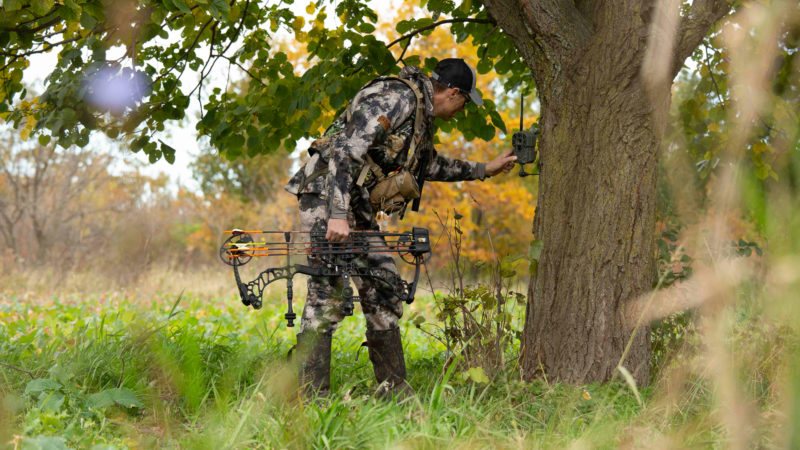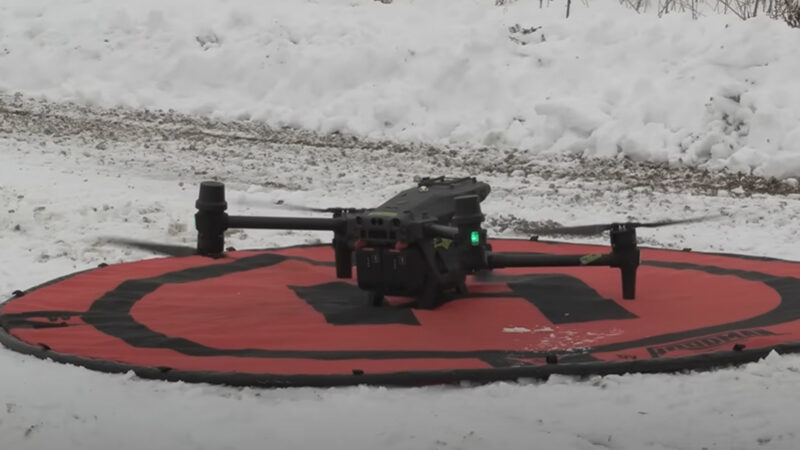LAST UPDATED: June 27th, 2024
Many times in life, we hear people say, “I wish there was an easy way to do this.” This is a major part of any sales pitch for almost any product advertised: this (insert product name) will make life easier. In many ways, this is the goal of all technology, even that associated with hunting. Many of these technological advancements have made hunting easier, but have they made it better, or have they taken things too far?
Let’s look at a few technological advancements in recent years and discuss some of the consequences of that technology. Have they made us better hunters, or have they made us apathetic? Have they made us more ethical, or have they caused us to push the boundaries of fair chase?

Cellular Trail Cameras
There’s no doubt that trail cameras have impacted the hunting industry, and cellular trail cameras have taken that impact one step further. What greater advantage can hunters have than getting actual proof, a photo or video, of the quality of bucks on their property and knowing exactly when they were there?
Now, cellular trail cameras assist with alerting us every time that buck is by our stand right now, with real-time information transmitted to our cell phones within just a few minutes of the photo being taken.
Two years ago, I purchased a cellular trail camera, and it was cool seeing photos of deer walking by my stand while I wasn’t there. Fortunately, cell phone reception in the mountainous region where I live (the dense forests of northcentral PA) isn’t reliable, so cellular cameras don’t work that great.

They often lack enough reception to even send the photos to my phone. I say “fortunately” because I noticed that my anticipation of the hunt waxed and waned according to how many times my phone dinged, or didn’t ding, that day with a new photo.
I didn’t like that feeling. I wanted to always feel eager to get on stand and hope something great would happen. Eventually, I decided that cellular trail cameras weren’t for me.
However, in areas with excellent cell phone reception, with smaller parcels of land and easy access, cellular trail cameras could be a huge advantage. Not only can you know the exact location of a buck, but also get a good idea of which way it is traveling so that you can formulate a plan to intercept it.
Or how about this. Imagine hunting a small parcel with a group of hunters. Imagine knowing that a huge buck is currently feeding in a small wood lot. How easy it could be to surround that wood lot and push the buck toward hunters in your group.
And yes, this is exactly what’s happening right now. Urban areas, open land with little tree cover, and areas with condensed food or water sources are perfectly suited for using cellular trail cameras to maximum effectiveness, which often pushes the boundaries of fair chase.
Ultimately, it’s up to conservation groups and wildlife protection departments to decide their ethical nature, and in recent years, Arizona, Delaware, Utah, Kansas, and others have banned the use of all trail cameras on public land.
Drones and Game Recovery Tools
Drones are another technological advancement that is also controversial in the hunting world. Used in an ethical manner, drones are a great tool for locating and recovering game after the shot. Used with ill intent, they are a great tool for pushing the boundaries of fair chase by giving hunters an unfair advantage.
Don’t get me wrong, I’m all for making every effort to recover wounded animals, but it’s hard to deny the potential for using drones in an unethical and illegal manner. The main contention is that drones can be used to locate animals that are not mortally wounded and would likely survive. But couldn’t drones also be used simply to locate where deer are bedded on a particular hillside or wood lot?

To a lesser extent, some game recovery tools, such as transmitters placed on arrows, have the same potential. Granted, most of these transmitters have a relatively short battery life (less than 24 hours), but how long will it be until technology improves enough that they’ll last several days? What happens, then, if the animal is not mortally wounded and hunters still have the capability to track the animal?
There’s a danger in relying on technology to recover mortally wounded game. It creates a false sense of security and leads us away from the basic skills that every bowhunter should possess, such as knowing how to properly track game and follow a blood trail. No matter how good it is, technology always has the potential to fail or not work as intended. Therefore, technology should not be a replacement for practical knowledge.

Rangefinding Bow Sights
Another technological advancement that attempts to replace practical knowledge is the rangefinding bow sight. These sights streamline the time and, more importantly, physical movement necessary to pull out your rangefinder, acquire the range of a target, get a reading, adjust your sights, and make the shot.
Once properly set up and installed, rangefinding bow sights not only measure the distance, but produces an electronic pin that tells you exactly where to aim on the animal.

It’s hard to argue against any technology that increases our chances for better shot placement and more humane kills, which is also why I’ll never criticize the improvement to various crossbows or vertical bows.
But again, I fear too many hunters will depend too much on this technology and consider it a replacement for the skills all bowhunters should possess. Knowing the anatomy of the animal you’re pursuing, knowing your equipment, and knowing your effective range are all part of being an ethical bowhunter.
eBikes
When I first started hunting vast tracts of public land, I used a regular mountain bike to access remote areas and forest roads. It was tough, and many days I didn’t feel like making the five-mile ride with my bow and other gear on my back.
But the deer I killed by doing that were awesome rewards for the effort. A few years ago, though, I traded in my mountain bike for an eBike, and hunting those remote areas has gotten a lot easier.

Of the technological advancements discussed so far, eBikes offer a different advantage.
They allow hunters faster and quieter access to stands. In some regions, they’ve opened up a lot of areas that were out of reach for many, especially for older hunters, and they can make hauling game out of the woods a much simpler task.
For these reasons, there’s been an incredible surge in the popularity of eBikes on public lands.

Like anything, though, eBikes can potentially be used illegally and unethically. One such way is when hunters fail to consult the regulations for eBike use on the lands they wish to hunt and just assume that all types of eBikes are legal to use everywhere. Every state views eBike use differently, and hunters should take note of those differences when hunting public or private lands.
For instance, where I hunt on state forest land, only Class 1 (pedal assist) eBikes are permitted, yet every day the Forest Ranger is citing someone in the parking lot for using a Class 2 or 3 (full throttle) eBike to hunt. Are full throttle eBikes an unfair advantage? Absolutely. They’re a fully motorized vehicle that produce none of the loud noises and zero effort to operate.
Smartphone Apps
Other technological advancements that I’ve used a lot in recent years are smartphone apps. Hunting apps like HuntStand and onX Hunt are incredibly useful for identifying property boundaries as well as topographical features to explore. It’s also ideal for marking stand and trail camera locations and making notes about each one.
Some map layers within these apps are so detailed that I can literally scout for deer from the comfort of my own home. When I finally put boots on the ground and go into those areas, I often find exactly what I predicted I’d find by just looking at the apps on my phone. Overall, this is a fantastic convenience that helps us become more efficient with our scouting and hunting efforts.

The main consequence of these smartphone apps is that traditional map reading is all but a lost art. Many of today’s hunters don’t even know how to use a compass. They rely solely on these apps for navigation. And yes, I understand that maps can be downloaded and used while offline. But what happens when you’re hunting or scouting unfamiliar ground and your phone battery dies and you’re still a long way from the vehicle?
Also, if you’re not careful, smartphone apps, in a similar way to cellular trail cameras, can make you lazy. Instead of putting actual boots on the ground and seeing for yourself what is going on in an area, it’s much easier to just rely on technology to tell you where and when to hunt.
Additional Concerns and Consequences
Technology is constantly advancing in our society, and we will continue seeing those advancements in hunting, too. Some of them are good. We all want to be more efficient and effective hunters, and tools that allows us to do that are always welcome. But we should have some concerns regarding the potentially negative consequences these advancements could have on future generations of hunters.
First of all, it seems many advancements are designed to make traditional bowhunting skills obsolete, from scouting and locating game to tracking and recovering them after the shot. As we introduce new hunters to the sport, it’s imperative that we continue to teach these basic, but necessary, skills, and to instill in them that technology is not a replacement for knowledge.

Second, technological advancements are aimed at making hunting easier, but easier isn’t always better. A major consequence of easy is apathy. When we get too used to something being easy, we feel like we haven’t earned it, and far too many people in our society today have forgotten the joy that comes with working hard to accomplish a goal.
In hunting, this means putting in the work and figuring things out for yourself instead of relying on a piece of technology to do it for you.
Third, every now and then it wouldn’t hurt to ditch many of these technological advancements and hunt without them – in fact, it’s highly recommended. That’s exactly what I did last year.
I didn’t put up a single trail camera, let my smartphone apps expire, and left my eBike at home. I didn’t even use a tree stand or ground blind and decided to hunt the old-fashioned way, sitting on a stool with my back against a tree.
The result? I killed my biggest big woods public land buck ever, a 6.5 year old, 150-inch 10-point. But more important than the actual kill was the thrill of using all the skills learned from 30 years of bowhunting to be successful.
I’m not knocking any of the technological advancements mentioned here, and I’m not criticizing the hunters who use them. But I do think it’s good to be aware of the rabbit hole that some of these advancements can take us down, and the potentially negative consequences of some of that technology.
There’s no doubt that technology can certainly make things easier – almost too easy at times – and it can cause us to neglect learning or refining some of the skills that every bowhunter should possess. More than that, it can cause us to forget that the best reward is often the one we work the hardest to achieve. In hunting and in life.

 By
By 



